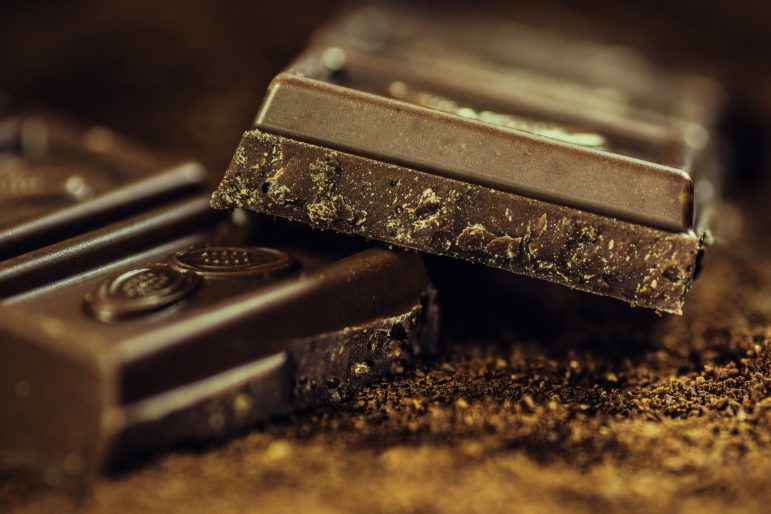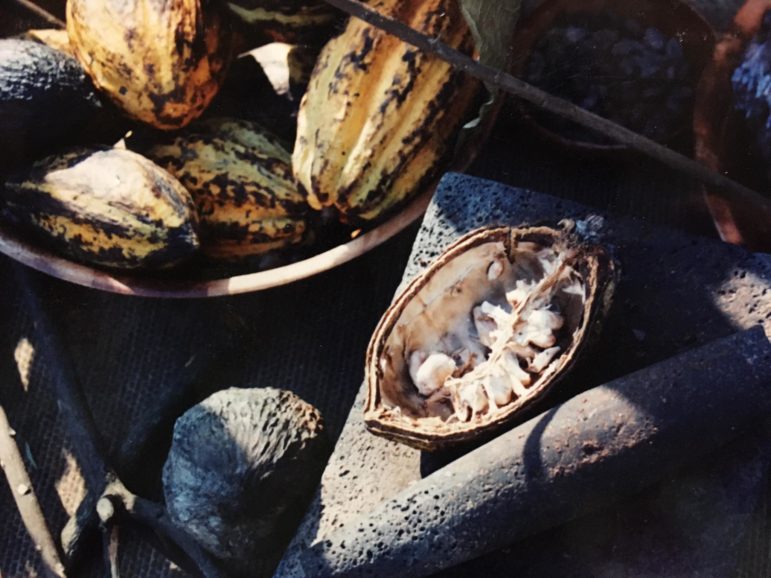TWH – A variety of people regularly enjoy chocolate, and it is incorporated into many foods and culinary delights, as well as being consumed as just a simple chocolate bar. Chocolate is more of a food product that requires processing than it is a food. Complex processing transforms it from a bean of the cacao tree to a mouthful of sensual pleasure.

Image credit: Alexander Stein via Pixabay
Like most food products, the manufacture of chocolate has negative environmental consequences. Cote d’Ivoire (Ivory Coast) and Ghana economically depend on chocolate production for export. Reducing its harm has to satisfy two groups: cravers of chocolate and workers of the cacao bean.
A brief history of chocolate
In 2022, the BBC Science Focus website reported on the history and process of making chocolate.
Native to the tropical rainforests of the Americas, chocolate was part of the Columbian Exchange. That term describes the colonial interaction and exchange of goods and people after Columbus. Chocolate, in that sense, carries heavy karma.
Chocolate begins as a bean of the cacao tree. Archaeologists have found evidence of human use of cacao as early as 3300 B.C.E. For the Mayans, it was a “thick, foamy, bitter drink.” From 250 to 900 C.E., cacao beans were used as currency.
The Aztecs (1345 to 1521) believed that Quetzalcoatl gave chocolate to humans as a gift, and drank cacao products for aphrodisiac and medicinal purposes.
How is chocolate made?
In nature, chocolate starts inside the pods of a small evergreen tree, Theobroma cacao. The pods of the cacao tree can grow to be as much as 35 cm (13.8 inches) in length.

Cacao Tree flowers – Image credit: Björn S. – CC BY-SA 3.0
Once pollinated, the flowers transform into pods that contain the beans. After roughly six months, the pods mature and ripen. The pods are hand-harvested by cacao farmworkers, who split the pods open to extract the beans embedded in a sweet, sticky, and viscous pulp.
Once the pulp and beans are removed from the pods, the beans are fermented. The fermentation process consists of either placing the cacao beans in piles on dry ground and covering them with banana leaves or in boxes that have drain holes. The beans are stirred every two days. Fermentation changes how the beans look, smell, and taste and takes anywhere from 6-10 days.
After the fermentation process is completed, farmworkers sun-dry the beans, which are then roasted. Roasting kills microorganisms and also enhances the flavor. Then the beans are sorted to remove any germinated, broken, or moldy beans. From there a cacao crusher is used to crack open the beans and separate the husks from the beans. A winnowing machine next removes the lighter husks and dust. What remains is referred to as the “nibs,” the part of the cacao bean used to make chocolate.
The nibs are ground into a powder, which tastes bitter. Spaniards brought cacao bean powder to Europe in the 16th Century. Only then did people begin to add sugar to the bitter drink of the Aztecs and Maya.
After this stage, the cacao powder is referred to as “cocoa.” The production process for making actual chocolate is complex and the quality of the end product depends on a variety of factors.
Cocoa production and environmental impacts
In “Negative environmental externalities within cocoa, coffee and oil palm value chains in Africa,” researchers Priscilla Wainaina, Peter Minang, and Judith Nzyoka discuss the environmental impact of chocolate production. They restrict their discussion to Cote d’Ivoire and Ghana. Those two countries produce 75% of the world’s total chocolate. At present, intense cocoa production leads to environmental harm.
Cocoa production employs more than 1,000,000 farmers in Cote d’Ivoire, roughly 4% of its population. In Ghana, 800,000 farmers grow cacao, roughly 2% of its population. About 90% of farm income in Cote d’Ivoire comes from cocoa. In Ghana, about 80% of farm income depends on cocoa.

Cacao beans and pods – Image credit: Eduardo Calavera – CC BY-SA 4.0
Wainaina, Minang, and Nzyoka found four types of negative environmental impacts linked to chocolate. Those harms include deforestation, pollution from fertilizers and pesticides, waste from processing cacao beans, and the production of greenhouse gasses.
The authors identified the four stages of the life cycle of chocolate. Those four stages are 1) production, 2) processing, 3) distribution and marketing, and 4) consumption of chocolate.
Environmental impacts in growing cacao
Cocoa production provides a needed cash crop for Cote d’Ivoire and Ghana. Growing cash crops on farmland precludes the growing of food crops on that same farmland.
As more people escape poverty, they want consumer goods like chocolate. This has increased the global demand for chocolate.

Cacao tree with ripening pods – Image credit: Björn S. – CC BY-SA 3.0
That increased demand has led to clearing forests to grow cacao. Between 2000 and 2018, the world’s largest producer of cocoa, Cote d’Ivoire, lost 19% of its tree cover. In that same period, Ghana lost 16% of its tree cover. That loss of tree cover killed trees storing carbon dioxide. As dead trees decay, they release their stored carbon dioxide.
Deforestation reduces habitats for species. It also displaces communities with less power than the cocoa industry.
Some producers engage in intensified production technologies rather than clear rainforests. Those intense production technologies heavily use fertilizer and pesticides, which have known environmental harms.
Pesticides impact human health through several pathways. First, pesticide residue may contaminate drinking water. Second, pesticides can remain on cocoa beans and end up in the human diet. Third, during pesticide application, pesticides may get onto human skin. When workers without protective gear apply pesticides to crops, humans suffer the worst damage.
Growing cacao beans produces 0.323 tonnes (712.1 lbs.) of carbon dioxide equivalent per tonne (2,204.6 lbs.) of chocolate. The term “carbon dioxide equivalent” includes all greenhouse gases, not just carbon dioxide. The production and use of fertilizers drive this production of greenhouse gases.
Environmental impacts in the processing of cocoa
Workers have to ferment the seeds of the cacao tree. They then have to extract the beans from their pods and husks. Those husks constitute about 67% of the fresh pod weight. One tonne (2,204.6 lbs.) of wet cacao beans will produce 50 liters (1.8 cubic feet) of pulp.
At cacao farms, that pulp is then drained off as liquid waste. Changing cacao into cocoa produces 0.28 to 1.91 tonnes (617.3 to 4210.8 lbs.) of carbon dioxide equivalent per tonne (2,204.6 lbs.) of chocolate.
Environmental impacts in the distribution and marketing of cocoa
Globalization requires the transport of goods across long distances. That transport almost always burns fossil fuels which produce greenhouse gases.
Distributing cocoa beans produce 0.22 to 0.39 tonnes (485.0 to 859.8 lbs.) of carbon dioxide equivalent per tonne (2,204.6 lbs.) of chocolate.
Environmental impacts of chocolate consumption
Chocolate packaging produces 0.3 tonnes (661.4 lbs.) of carbon dioxide equivalent per tonne (2,204.6 lbs.) of chocolate.
Policies to minimize harm in cocoa production
Agroforestry refers to a set of sustainable practices for intense cocoa production. The U.S. Department of Agriculture defines agroforestry as “the intentional integration of trees and trees into crop and animal farming systems to create environmental, economic, and social benefits.”
Under agroforestry, the farmer has many income streams from different crops. As agroforestry increases tree cover, it will increase the absorption of greenhouse gases. Among other benefits, it also promotes biodiversity.
A zero-deforestation commitment occurs when a cocoa producer makes a public commitment to respect forest boundaries.
NGOs or governments monitoring cocoa farms for sustainability issue certifications of sustainability. Some groups will also certify fair labor practices. Unfair labor practices are another harm associated with cocoa production.
Some certifying groups will pay cocoa farmers a premium over the market price for cocoa. At present, cocoa farmers fail to receive a “living wage” at market value.
Governments can issue regulations to limit pesticide use. Governments can also require improvements in waste treatment during processing.
These policies could reduce the environmental harm from cocoa production. People do not have to give up chocolate, but they may have to pay more. The economies of Cote d’Ivoire and Ghana could develop cocoa as a cash crop for export. Ethical consumers of chocolate, however, should advocate for the enactment and enforcement of sustainable policies.
The Wild Hunt is not responsible for links to external content.
To join a conversation on this post:
Visit our The Wild Hunt subreddit! Point your favorite browser to https://www.reddit.com/r/The_Wild_Hunt_News/, then click “JOIN”. Make sure to click the bell, too, to be notified of new articles posted to our subreddit.